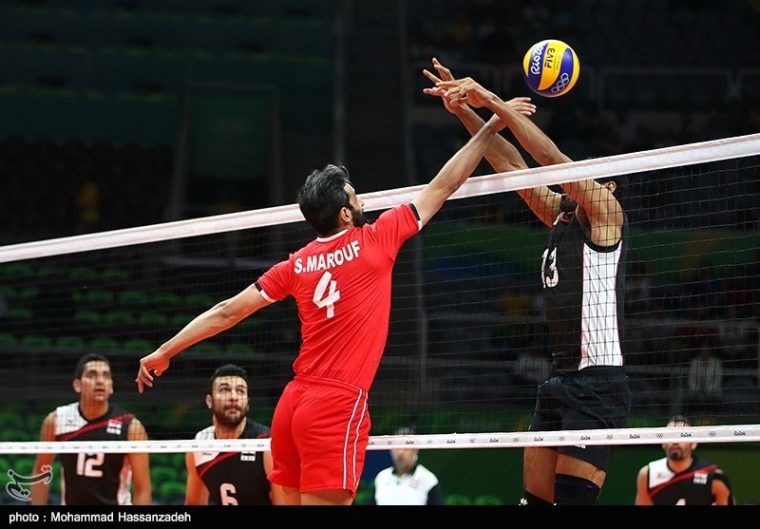Volleyball Rules and Regulations
If you’re on this page then you’re probably new to volleyball. It’s ok, we’ve all been new to something at one point or another. But I’m sure you’ve realized, there’s much more to volleyball than the “everyone just try to get the ball over the net” mentality that you see in gym class.
New volleyball players can become overwhelmed with the amount of information thrown their way. They may say things like, “What are the volleyball rules and regulations?” or “Did you say bic? Like the lighter brand?”.
If this is you, or you just want to learn a bit more about the game, you’ve come to the right place. Take a look below at some of the most important volleyball rules and regulations, as well as the most common volleyball terms used around the world.
Volleyball Rules and Regulations: Basics
- Each team is composed of six players – Three players in the front row and three players in the back row.
- The game begins with a serve – The serve comes from behind the end line on the volleyball court.
- Each team gets three touches – Each team is allowed to touch the ball three times before it must return to the other side of the net. If contact is made for a fourth time, the play is dead and the other team will receive a point. Teams CAN hit it less than three times if they wish to do so.
- Hit the floor to score – Points are scored when the volleyball lands “in”, on the opposing team’s side of the court (“in” means that the ball traveled over the net and landed within the court of play).
- The line is “in” – If the ball hits the court boundary, it is considered to be “in”.
- Points are also scored when the opposing team hits the ball “out”. The ball is considered “out” if it lands out of the court boundaries, hits the antenna, or makes contact with the ceiling.
- The ball CAN touch the net on it’s way over – The ball is allowed to make contact with the net regardless of if it is on a serve, attack, block, etc.
- You can play the ball off of the net – If the ball is driven off of the net, you can continue to play it as long as it is within your team’s three contacts.
- If the team that served wins the point, they will continue to serve. If they lose the point, the opposing team will become the servers.
- Teams rotate clockwise when they become the servers – This means that one front row player will become a back row player and vice versa.
- Game ends at 25 points – The game is over when one team scores a designated amount of points (most often 25).
Volleyball Rules and Regulations: Court Violations
- Individual players cannot hit the ball two consecutive times.
- Contact must be instantaneous – Players cannot catch or hold the volleyball.
- Double hit – hitting the ball twice during the same action. You can only double hit if it occurs during the team’s first contact (during serve receive or after an opponents attack).
- Players cannot assist a teammate with hitting the ball – This means that you can’t help a teammate by throwing them into the air or allowing them to jump off of your back in an effort to hit the volleyball.
- Under the net violation – Players cannot cross the center line inside the court of play. This is a tricky one because there are certain rules surrounding an “under” violation. The rule states that your entire foot needs to be under the net (meaning your whole body can be over the line as long as your foot isn’t and you aren’t effecting the play) but it is ultimately up to the referees discretion.
- Out of rotation – This can occur if you serve out of rotation as well as if you are not in rotation during the opposing team’s serve.
- Back row attack – This is when a player attacks the ball over the net while they are in the back row (according to their rotation).
- Libero cannot:
- Attack the ball over the net regardless of where they are on the court.
- Overhand set a front row attack while they are standing in front of the ten foot line.
- Block. Ever.
Volleyball Rules and Regulations: Net Violations
- You cannot block a serve – You must allow the opposing team’s serve to come over the net. Blocking the serve is illegal and will result in a point for the serving team.
- Over the net violation – You cannot penetrate the net unless the opposing team is attacking. This means that you are not allowed to block a set from the opposing team.
- The ball must be inside the antenna – If you hit the ball outside of the antenna (or if it hits the antenna) it is considered to be out of play regardless of where it lands.
- Net violation – You cannot make contact with the top of the net during an action such as an attack or block. You CAN make contact with the net if it does not effect the play (referee’s discretion).
- Screening – You cannot create a wall of players to “screen” the opposing team while you are serving.
Volleyball Terms
Now that you know the ins and outs of the game, it’s a good time to get accustomed to the more notable volleyball terms. Below you will find popular volleyball terminology that is used around the world.
The volleyball terms are separated into sections based on how they relate to the game. The sections include court terminology, volleyball actions, volleyball sets, positional terminology, and misc. terminology.
Use this more of a reference than anything else. Volleyball is a very friendly game so whoever you are playing with will most likely be happy to clarify any questions that you have. With that being said, glancing over the volleyball terms below can help you be prepared the next time someone wants you to run a four ball!
Volleyball Court
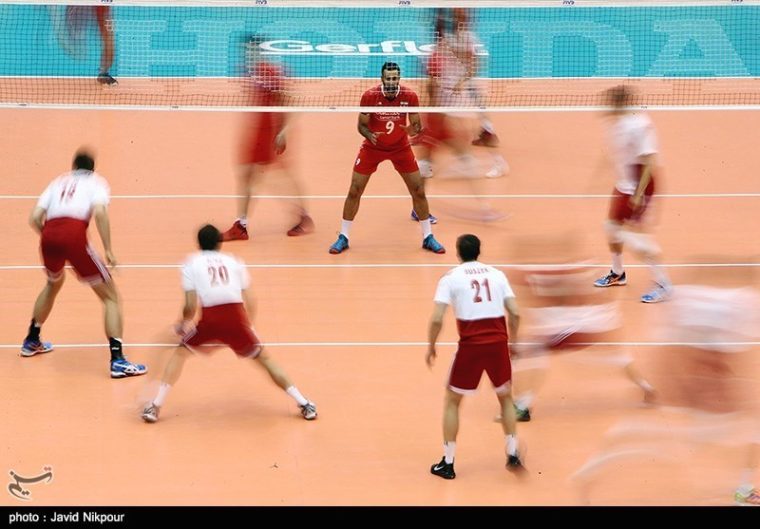 The volleyball terms below are things you might hear when someone is describing the volleyball court itself. It is impossible to hit an angle shot that lands on the 10 foot line if you have no idea what that means.
The volleyball terms below are things you might hear when someone is describing the volleyball court itself. It is impossible to hit an angle shot that lands on the 10 foot line if you have no idea what that means.
Familiarize yourself with the volleyball court as best as you can! As you become more comfortable, your body will take over and the game will become second nature.
Volleyball Terms: Court Terminology
10 Foot Line / 3 Meter Line – The line ten feet from the center of the volleyball court that signifies where a back row player must leave the ground in order to attack the ball.
Angle – Hitting across the court in a diagonal fashion from the pin to the opposite side.
Back Row – The three volleyball players in the rotation positioned behind the 10 Foot Line. By rule, they cannot attack the volleyball without leaving the ground before the 10-Foot Line.
Center Line – The line separating the two sides of the volleyball court. Crossing the center line during a rally may result in a violation (resulting in a point for the opposing team).
Front Row – The three volleyball players in the rotation that are closest to the net and therefore can attack the volleyball while being in front of the 10-Foot Line.
Line – Hitting straight from the pin down the line in efforts to avoid the block.
Seam – Hitting between the double or triple block.
Volleyball Actions
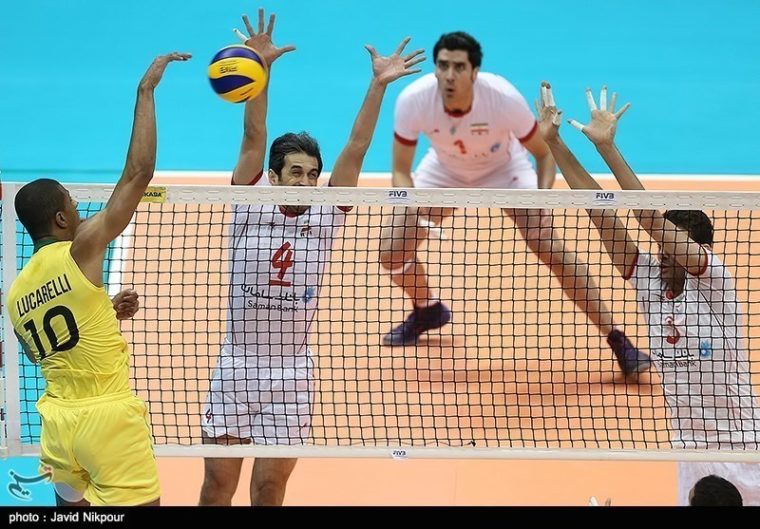 These volleyball terms are a collection of things that you DO on the volleyball court. Digging, jousting, and popping a ball up with a pancake are things you are likely to come across on the volleyball court. It’s important to know what the heck these terms mean so you don’t end up digging a hole for your breakfast cake right before a Renaissance festival!
These volleyball terms are a collection of things that you DO on the volleyball court. Digging, jousting, and popping a ball up with a pancake are things you are likely to come across on the volleyball court. It’s important to know what the heck these terms mean so you don’t end up digging a hole for your breakfast cake right before a Renaissance festival!
Read up on the meanings of these volleyball terms and don’t be afraid to use them at your next volleyball practice!
Volleyball Terms: Actions
Assist – A statistic that is awarded to the player who “sets” a hit that results in a kill.
Attack – Offensively hitting the volleyball in an effort to win a point. A spike is often times considered to be an attack.
Back Row Attack – A type of volleyball attack in which a back row player leaves the ground prior to the ten foot line and spikes the ball over the net.
Block – A volleyball block occurs when one or more front row players stop the opponents attack from crossing the net and send the ball back onto the side in which it came.
Bump Pass – A volleyball pass in which the player strikes the volleyball with their flattened forearms.
Carry – Making contact with the volleyball for too long of a period of time. A volleyball carry most likely occurs when a player is setting and they “catch” the ball.
Closing the Block – Making sure that there are no gaps between two or more blockers.
Cover the Hitter – Surrounding your teammate while they hit the volleyball in an effort to pop the ball back up if it gets blocked by the opposing team.
Cut – A cut is a volleyball shot in which the hitter hits at a sharp angle to the other side of the volleyball court.
Dig – A volleyball dig occurs when a player passes the ball that has been attacked by the opposing team.
Dime – A slang volleyball term for a perfect pass to the setter.
Double Block – A block consisting of two front row players.
Double Hit – The illegal action of a player hitting the volleyball twice in a row.
Gator – A type of two handed volleyball dig made popular by beach volleyball players. Learn from the best and let Danny Kinda show you how it’s done.
Joust – Two opposing blockers reaching the ball above the volleyball net at the same time and attempting to push it to the opposite side.
Kill – A volleyball hit that immediately results in a point for the attacking team.
Overhead Pass – A volleyball pass in which the player controls the volleyball with their fingertips while their face is below the ball and elbows are flared out to the sides.
Pancake – Sliding your hand in between the volleyball and the floor just before the ball makes contact therefore popping it back up into play.
Penetrate – Reaching over the volleyball net while you are blocking.
Roll – An off-speed shot with spin that is hit with less than full power.
Roof – A slang volleyball term for blocking the opponent’s attack straight down to the ground thus resulting in a point for the team on defense.
Set – Directing a ball to a certain location so a hitter can attack the volleyball.
Setter Dump – Sending the volleyball to the opposing team’s side of the court on the second contact. Usually performed in a way to disguise the action and therefore catching the other team off guard.
Shank – A bad volleyball pass that ends up far off of the target line.
Sky Serve – A volleyball serve (most seen in beach volleyball) in which the player strikes the ball in an upward motion sending the volleyball as high as possible in hopes the opposing team misjudges where the ball will land.
Soft Block – A blocking technique in which the player takes a slight step off of the volleyball net and jumps while raising their open hands towards the ceiling to slow the attack for the defense behind them.
Tip – An off-speed shot sent over the net with a players fingertips.
Tool – A volleyball hit that goes off of the opposing block and drops to the floor for a point.
Touch – A blocker or defensive player making contact with the volleyball after it was attacked by the opposing team.
Transition – The switch between offense and defense.
Trap Set – Setting the volleyball very close to the net so the hitter has nowhere to go but straight into the opposing team’s block.
Triple Block – A block consisting of all three front row players.
Underhand Serve – A volleyball serve in which the player strikes the ball underhand thus creating a “rainbow” trajectory over the volleyball net.
Volleyball Hit – A volleyball hit occurs when a player strikes the ball in an offensive manner in efforts to have it land on the opposing team’s side of the court.
Volleyball Set
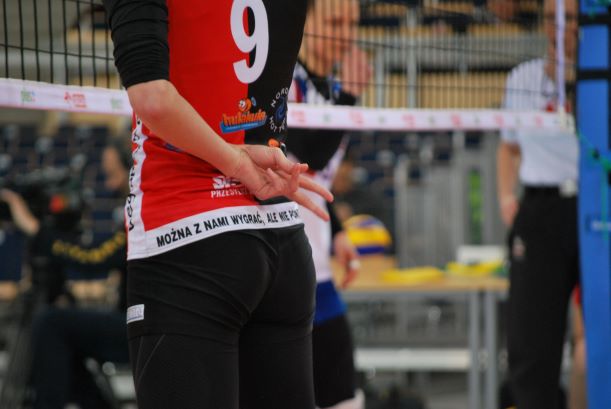 Learning the names of each volleyball set is extremely important for new volleyball players. You cannot run an offense if the setter isn’t on the same page with the hitters! Study the volleyball terms below so you know what to do when you setter tells you to run a one ball.
Learning the names of each volleyball set is extremely important for new volleyball players. You cannot run an offense if the setter isn’t on the same page with the hitters! Study the volleyball terms below so you know what to do when you setter tells you to run a one ball.
Volleyball Terms: Set Terminology
(set locations coincide to player facing the volleyball net)
A Set – A set for a back row player that is located near the left sideline.
Back One – A quick set to the middle hitter that is located just behind the setter.
Bic – A volleyball set for a back row player located in line with the setter’s left shoulder. It is quick and usually run in conjunction with a one.
D Set – A volleyball set for a back row player that is located near the right sideline.
Five Set (Back Set) – A front row set to the opposite hitter located close to the net on the right side of the court.
Four – An arched front row set to the outside hitter located close to the net on the left side of the court.
One – A quick set to the middle hitter that is located just in front of the setter.
Pipe – A set for a back row player that is located in the middle of the court.
Shoot – A quick set to the outside hitter located close to the net on the left side of the court. The shoot relies on timing in order to beat the block.
Slide – A quick back set to the right side pin for the middle hitter.
Tandem – A volleyball play in which the middle runs a one ball while the outside hitter runs a two ball to the left of the middle.
Three (Thirty One) – A quick set located between the middle of the volleyball court and the left sideline.
Two – A set straight up above the setter that is usually 3 – 5 feet above the net.
X – A volleyball set in which the middle runs a one ball and the opposite crosses behind and runs a two ball to the left of the middle.
Volleyball Positions
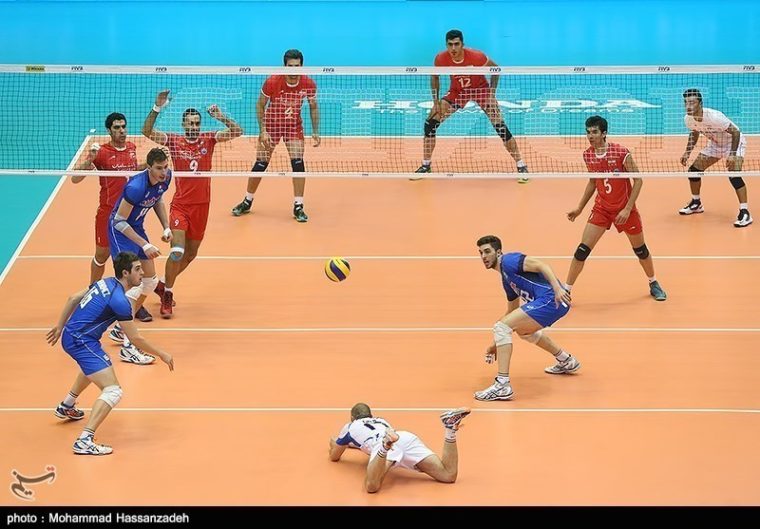 The positional terminology relates to volleyball terms that you might hear when someone is describing the position they play on the court. The volleyball positions are Outside Hitter (Left side / Wing Spiker), Middle Hitter (Middle Blocker), Opposite Hitter (Right Side, Wing Spiker), Setter, Libero, Defensive Specialist, and Serving Specialist.
The positional terminology relates to volleyball terms that you might hear when someone is describing the position they play on the court. The volleyball positions are Outside Hitter (Left side / Wing Spiker), Middle Hitter (Middle Blocker), Opposite Hitter (Right Side, Wing Spiker), Setter, Libero, Defensive Specialist, and Serving Specialist.
Take a look below at a quick description of each volleyball position. If you are interested in learning about the roles and responsibilities of each, click here!
Volleyball Terms: Positional Terminology
Libero – A defensive specialist who stays in the game the entire time but never goes into the front row in regards to the volleyball rotation. Once in the game, they can never cross the height of the net if they chose to attack a ball.
Setter – The player responsible for running the offense and setting the ball to the hitters on the volleyball team. They are often referred to as the quarterback of the volleyball court.
Middle Hitter / Middle Blocker – The player who plays in the middle of the court while in the front row. He or she is usually the tallest player on the volleyball team and is most responsible for getting blocks for the defense.
Opposite Hitter / Right side Hitter – The player who plays on the right side of the court while in the front row. Similar to the middle hitter, this player concentrates heavily on front row defense and is tasked with blocking the opposing outside hitter.
Outside Hitter – The player who attacks the volleyball from the left side of the court while he or she is playing in the front row.
Volleyball Passer / Defensive Specialist (DS) – A player designated to play back row for another player in an effort to be better on defense.
Serving Specialist – A player whose primary responsibility is to come in the game and serve the volleyball. While in the game, they play defense at their respective position.
Volleyball Spiker – The player attacking the ball in an effort to end the play and win the point.
Volleyball Terms: Misc. Terminology
4-2 – A volleyball system in which there are two setters. In this system, the setter is always front row and there are always two hitters.
5-1 – A volleyball system in which there is one setter.
6-2 – A volleyball system in which there are two setters. In this system, the setter is always back row and there are always three hitters.
Antenna – The vertical rods that are placed on the net to indicate the boundaries of the volleyball net. Hitting the antenna with the volleyball is a violation and will result in a point for the opposing team.
Blocking Error – A block that results in one of the following: the ball hits the block and lands out, the ball hits the block and lands on the blocker’s side of the court, the blocker illegally crosses the center line, the blocker illegally touches the net, the blocker interferes with the opposing team prior to their third contact.
Decoy – The player who is distracting the opposing defense but does not actually get set. Middle hitters are often very good at being decoys.
Down Ball – Hitting a volleyball in a spike-like manner towards another player in order to begin a drill.
Free Ball – An easily passable ball sent over the net by the opposing team.
Float Serve (Floater) – A volleyball serve in which the player strikes the volleyball with an open hand and subsequently stops the follow through thus creating a serve with little spin and erratic movement (similar to a knuckle ball in baseball).
Hitting Approach – The steps and subsequent arm swing that take place in preparation to attack the volleyball.
Hitting Error – A hit that results in one of the following: the volleyball lands out, the hitter commits a center line violation, the hitter commits a net violation, the ball is blocked for a point, the hitter is called for a contact violation, or the hitter hits the ball into the net.
Hitting Percentage = Kills – Errors / Attempts
Jump Serve – A volleyball serve in which the player tosses the volleyball, takes a hitting approach, and strikes the ball in a spiking motion over the volleyball net.
Linesman – The referees that are located on the corners of the volleyball court. They are usually responsible for calling the ball “in”, “out”, or indicating that it was touched.
Out of Rotation – Illegally starting a point (prior to the serve) while not in the correct rotation. The players are free to move laterally once the opposing server makes contact with the ball.
Overpass – Passing the volleyball over the net on the first contact.
Pepper – A warm up game that consists of two players passing, then setting, then hitting to each other in a continuous cycle.
Platform – The base that you make with your arms when you are attempting to bump pass or dig.
Rally Scoring – A type of scoring where both the serving team and serve receiving team can earn a point.
Ready Position – An athletic position with your feet shoulder width apart, knees slightly bent, and weight forward. Also called the, “defensive position”.
Rotations – Volleyball rotations are the clockwise rotation of players through the serving position.
Service Error – A bad serve that results in the other team getting a point. This occurs when the server commits a foot fault, the serve lands out of bounds, or the serve does not get over the volleyball net.
Shag – Gathering the loose balls and placing them in the volleyball carts.
Side Out – A change in which team is currently serving the volleyball. This occurs when the serve receive team scores a point and therefore becomes the serving team.
Side Out Scoring – A type of scoring where you are only rewarded a point if you are serving.
Tape – The top of the volleyball net.
Telegraph – Unintentionally showing the opposing defense your intentions prior to setting the volleyball.
Volleyball Game (Set) – A single volleyball game that is played to a predetermined amount of points.
Volleyball Match – A group of volleyball sets ending when a team wins the best of 3 or best of 5.
If you’ve made it this far then you have quite the determination! Volleyball is an extremely rewarding game so if you’re new, learn what you can each day (you definitely don’t need to know everything right away).
Use this article as a reference as you start your volleyball career. If you hear a new word, come on back and see if it’s on this list. If it’s not, leave a comment below so we can help the next generation of volleyball players!
